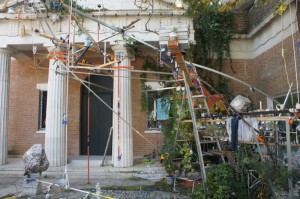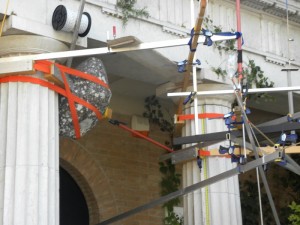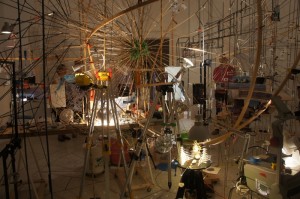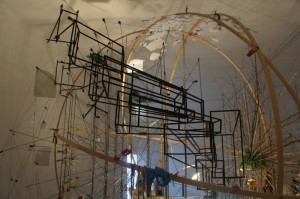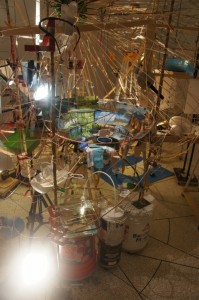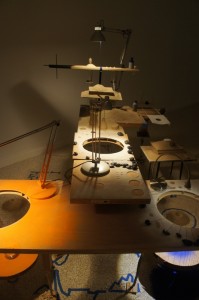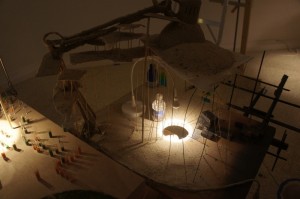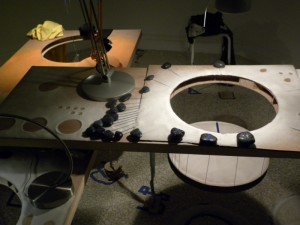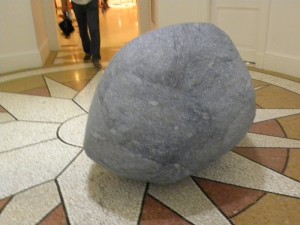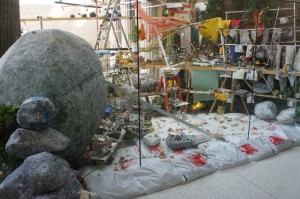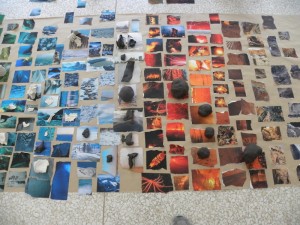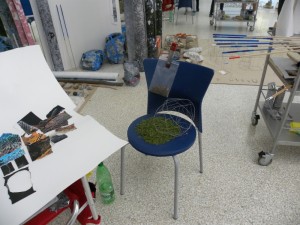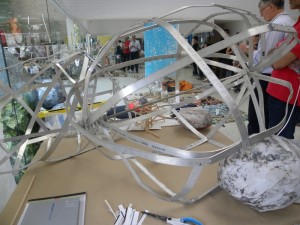Sarah Sze “Triple Point” The US Pavilion at the Venice Biennale
We could feel our expectations shifting as we approached the pavilion from the back, from the Czech pavilion, instead of front and center facing the traditional classical portico. We could see trails of stones on the ground and little piles of stones in alcoves and on ledges. Is this part of the exhibition?
It is clear that they are as soon as we reach the front of the pavilion, where the building looks as though it is under construction, and in a state of emergency: a high ladder with its steps covered with stones, pieces of wood, and plants, leads to a high platform, but the access to it is blocked by a two by four, supporting a stack of concrete blocks. Long aluminum struts reach into space and precariously construct another jerry-rigged support system that looked like it was about to collapse. Reaching up to the roof of the classical pavilion are more rods and on top what looks like a huge rock, barely balanced there. Looking closer there are more rocks at other points on the edge of the roof and stacks of what appear to be concrete paving stones.
This sense of impending collapse, or disaster, of jerry-rigged constructions, improvisation and making do is the perfect metaphor for where the US is today. Of course, no reviewers are touching that idea. They settle for enumeration of just a few of the dozens of found objects and materials that Sze uses in her installations. And it is an overwhelming exercise to name even a few of the hundreds of tiny things, both “found” ( I suspect not accumulated over time, but more like ready-mades from the store), and constructed.
Inside the pavilion the sense of disintegration continues. In every room, the artist began by drawing in black tape on the floor, the compass in marble that is set in marble in the entrance foyer of the pavilion. But instead of providing a sense of purposeful order, the compass is the basis for overwhelming complexity.
The title of the pavilion, Triple Point, is a term in thermodynamics that refers to a moment when, according to the exhibition brochure “all three phases of a substance (gas, liquid and solid) can exist in perfect equilibrium.” That sense of transformation of solid into air, of air into liquid, liquid into gas permeated the exhibition metaphorically, everything is in transition, is suspended in a state that is improbabe, optically inpenetrable,and mentally stimulating.
Rising above our heads in the first room is an outline in curved wood of part of a globe, cut across by a black metal geometric structure that evokes a staircase. There is also the sense of a burst of energy like an exploded tree with the branches reaching out (from a green center), attached to a fragment of a network (geodesic?). Below are fragments of pictures of landscapes arranged as though in an amphitheater. The structure is supported by various props including large empty cans of paint. It seemed like science fragmented, reminding me of one of those works of art of the 1960s, like Tingueley’s that were meant to be destroyed, but in this case there is no destruction, only a limbo of parts that are suspended in an improbable relationship to one another. There are interdependent in a profound, but fragile way, that is the same that can be said of human existence. Given the destruction of the planet currently underway, I could not help but see a reference to that here.
The next room was more intimate, like a laboratory with multiple stations, but this laboratory has holes in the tables; it is non functioning. Even as we look closely, we feel tricked by the spaces and voids. Black stones taped with blue are scattered around the edges of these strange work stations. Are they the future of life, are they the past of life? On some level, we know they are both and neither.
In the entrance foyer is a big rock sitting on that compass in the marble floor. But this, like all the large rocks in and on and above the pavilion, we now realize, is not a real rock. It is based on a photograph of a rock that has been projected onto a plastic material and wrapped around an aluminum armature (ecological Sze is not). The rock in the foyer is on a real compass, but our sense of order based on the compass is disrupted by unexpected obstacles that are not what they seem to be.
The next room is like an amphitheater in which objects are lined up like spectators; these spectators are the infinite array of Sze’s objects all sorted by size, color, material, to create what appears to be a rational order for the first time in the exhibition. But again, there is the sense of suspended animation, of something about to change, for these are the materials of her art, of our consumer culture, of our rubbish overrun planet, they are all going to be trash shortly, when the exhibition is over. But for this brief moment, they are arrayed, viewing the empty arena before them. (I can easily read it this way because when I was a child, my father used to array inanimate objects in parades through our New York City apartment).
Finally, there is the artist’s studio, in which she shows us her tricks, the rocks made from paper, wrapped around armatures, the collections of colored paper that stand in for nature.
The game of solid and transparent, of fiction and reality, fantasy and fact, is the theme of the exhibition. But I felt strongly that the real issue here was the breakdown of those barriers, the breakdown of the rational solution, the traditional belief system, the decomposing of reality, of expectations, of predictions into a triple point of ideas, objects and transparencies.
This entry was posted on November 18, 2013 and is filed under Art and Activism, Art and Politics Now, art criticism, Art of Democracy, Conceptual Art, Contemporary Art, Uncategorized, Venice, Venice Biennale.

